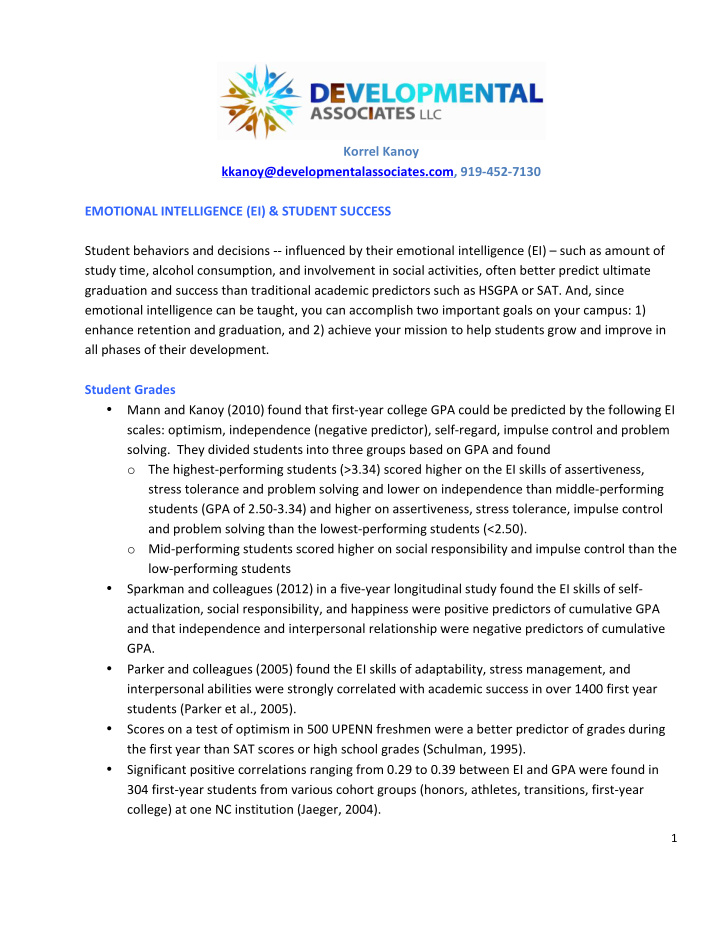



¡ ¡ Korrel ¡Kanoy ¡ kkanoy@developmentalassociates.com, ¡919-‑452-‑7130 ¡ ¡ EMOTIONAL ¡INTELLIGENCE ¡(EI) ¡& ¡STUDENT ¡SUCCESS ¡ ¡ Student ¡behaviors ¡and ¡decisions ¡-‑-‑ ¡influenced ¡by ¡their ¡emotional ¡intelligence ¡(EI) ¡– ¡such ¡as ¡amount ¡of ¡ study ¡time, ¡alcohol ¡consumption, ¡and ¡involvement ¡in ¡social ¡activities, ¡often ¡better ¡predict ¡ultimate ¡ graduation ¡and ¡success ¡than ¡traditional ¡academic ¡predictors ¡such ¡as ¡HSGPA ¡or ¡SAT. ¡And, ¡since ¡ emotional ¡intelligence ¡can ¡be ¡taught, ¡you ¡can ¡accomplish ¡two ¡important ¡goals ¡on ¡your ¡campus: ¡1) ¡ enhance ¡retention ¡and ¡graduation, ¡and ¡2) ¡achieve ¡your ¡mission ¡to ¡help ¡students ¡grow ¡and ¡improve ¡in ¡ all ¡phases ¡of ¡their ¡development. ¡ ¡ ¡ ¡ Student ¡Grades ¡ • Mann ¡and ¡Kanoy ¡(2010) ¡found ¡that ¡first-‑year ¡college ¡GPA ¡could ¡be ¡predicted ¡by ¡the ¡following ¡EI ¡ scales: ¡optimism, ¡independence ¡(negative ¡predictor), ¡self-‑regard, ¡impulse ¡control ¡and ¡problem ¡ solving. ¡ ¡They ¡divided ¡students ¡into ¡three ¡groups ¡based ¡on ¡GPA ¡and ¡found ¡ ¡ o The ¡highest-‑performing ¡students ¡(>3.34) ¡scored ¡higher ¡on ¡the ¡EI ¡skills ¡of ¡assertiveness, ¡ stress ¡tolerance ¡and ¡problem ¡solving ¡and ¡lower ¡on ¡independence ¡than ¡middle-‑performing ¡ students ¡(GPA ¡of ¡2.50-‑3.34) ¡and ¡higher ¡on ¡assertiveness, ¡stress ¡tolerance, ¡impulse ¡control ¡ and ¡problem ¡solving ¡than ¡the ¡lowest-‑performing ¡students ¡(<2.50). ¡ o Mid-‑performing ¡students ¡scored ¡higher ¡on ¡social ¡responsibility ¡and ¡impulse ¡control ¡than ¡the ¡ low-‑performing ¡students ¡ • Sparkman ¡and ¡colleagues ¡(2012) ¡in ¡a ¡five-‑year ¡longitudinal ¡study ¡found ¡the ¡EI ¡skills ¡of ¡self-‑ actualization, ¡social ¡responsibility, ¡and ¡happiness ¡were ¡positive ¡predictors ¡of ¡cumulative ¡GPA ¡ and ¡that ¡independence ¡and ¡interpersonal ¡relationship ¡were ¡negative ¡predictors ¡of ¡cumulative ¡ GPA. ¡ • Parker ¡and ¡colleagues ¡(2005) ¡found ¡the ¡EI ¡skills ¡of ¡adaptability, ¡stress ¡management, ¡and ¡ interpersonal ¡abilities ¡were ¡strongly ¡correlated ¡with ¡academic ¡success ¡in ¡over ¡1400 ¡first ¡year ¡ students ¡(Parker ¡et ¡al., ¡2005). ¡ • Scores ¡on ¡a ¡test ¡of ¡optimism ¡in ¡500 ¡UPENN ¡freshmen ¡were ¡a ¡better ¡predictor ¡of ¡grades ¡during ¡ the ¡first ¡year ¡than ¡SAT ¡scores ¡or ¡high ¡school ¡grades ¡(Schulman, ¡1995). ¡ ¡ • Significant ¡positive ¡correlations ¡ranging ¡from ¡0.29 ¡to ¡0.39 ¡between ¡EI ¡and ¡GPA ¡were ¡found ¡in ¡ 304 ¡first-‑year ¡students ¡from ¡various ¡cohort ¡groups ¡(honors, ¡athletes, ¡transitions, ¡first-‑year ¡ college) ¡at ¡one ¡NC ¡institution ¡(Jaeger, ¡2004). ¡ ¡ 1 ¡ ¡
• Song ¡and ¡colleagues ¡(2010) ¡found ¡that ¡both ¡general ¡mental ¡abilities ¡and ¡emotional ¡intelligence ¡ contribute ¡in ¡unique ¡ways ¡to ¡the ¡predicting ¡academic ¡performance. ¡ ¡Emotional ¡intelligence, ¡but ¡ not ¡general ¡mental ¡abilities, ¡also ¡predicted ¡the ¡quality ¡of ¡students’ ¡social ¡interaction. ¡ • Evenson ¡(2008) ¡found ¡that ¡students ¡on ¡the ¡Dean’s ¡List ¡had ¡higher ¡emotional ¡intelligence ¡scores ¡ than ¡students ¡on ¡academic ¡probation. ¡ ¡ ¡ • Berenson, ¡Boyles, ¡and ¡Weaver ¡(2008) ¡found ¡that ¡the ¡most ¡significant ¡predictor ¡of ¡grades ¡in ¡ online ¡courses ¡was ¡emotional ¡intelligence. ¡ ¡ Retention ¡and ¡Graduation ¡ • Keefer, ¡Parker ¡and ¡Wood ¡(2012) ¡found ¡that ¡the ¡failure ¡to ¡graduate ¡six ¡years ¡after ¡enrollment ¡ for ¡an ¡initial ¡sample ¡of ¡1015 ¡students ¡could ¡be ¡predicted ¡by ¡lower ¡emotional ¡intelligence ¡scores ¡ on ¡interpersonal ¡and ¡stress ¡management ¡domains, ¡even ¡after ¡controlling ¡for ¡high ¡school ¡grades ¡ and ¡gender. ¡ ¡ • Parker ¡and ¡his ¡colleagues ¡(2005) ¡examined ¡differences ¡between ¡matched ¡samples ¡(based ¡on ¡ gender ¡and ¡ethnicity) ¡of ¡students ¡who ¡withdrew ¡before ¡the ¡second ¡year ¡of ¡study ¡ ¡(n=213) ¡and ¡ those ¡who ¡enrolled ¡for ¡their ¡second ¡year ¡(n=213). ¡ ¡Those ¡who ¡were ¡retained ¡were ¡higher ¡on ¡a ¡ significant ¡number ¡of ¡EI ¡characteristics ¡compared ¡with ¡those ¡who ¡withdrew. ¡ ¡ ¡ ¡ • Kanoy ¡(2011) ¡in ¡a ¡longitudinal ¡study ¡of ¡entering ¡students ¡and ¡graduation ¡four ¡years ¡later ¡found ¡ that ¡first-‑year ¡students ¡who ¡were ¡not ¡retained ¡were ¡lower ¡in ¡impulse ¡control ¡and ¡optimism ¡ than ¡first-‑year ¡students ¡who ¡were ¡retained . ¡ Seniors ¡who ¡graduated ¡four ¡years ¡after ¡enrollment ¡ were ¡higher ¡than ¡non-‑graduates ¡on ¡7 ¡EI ¡skill ¡areas ¡as ¡first-‑year ¡students ¡including: ¡self-‑regard, ¡ self-‑actualization, ¡independence, ¡social ¡responsibility, ¡reality ¡testing, ¡impulse ¡control ¡and ¡ happiness. ¡ ¡There ¡were ¡no ¡differences ¡related ¡to ¡entering ¡academic ¡ability ¡as ¡measured ¡by ¡ grades ¡and ¡HS ¡GPA. ¡ • Sparkman ¡(2012) ¡in ¡a ¡longitudinal ¡project ¡involving ¡783 ¡college ¡students ¡studied ¡over ¡a ¡5-‑year ¡ period ¡found ¡social ¡responsibility, ¡followed ¡by ¡impulse ¡control, ¡and ¡empathy ¡were ¡the ¡three ¡ strongest ¡positive ¡predictors ¡of ¡graduation. ¡ ¡ Flexibility ¡was ¡a ¡negative ¡predictor ¡of ¡graduation. ¡ • Pritchard ¡and ¡Wilson ¡(2003) ¡reported ¡a ¡positive ¡relationship ¡between ¡stress, ¡alcohol ¡use, ¡and ¡ attrition. ¡ ¡Students ¡with ¡lower ¡stress ¡were ¡more ¡likely ¡to ¡be ¡retained ¡and ¡to ¡use ¡less ¡alcohol. ¡ • Qualter ¡and ¡colleagues ¡(2009) ¡found ¡in ¡two ¡different ¡studies ¡that ¡1) ¡emotional ¡intelligence ¡ successfully ¡predicted ¡which ¡students ¡would ¡be ¡retained ¡to ¡year ¡2 ¡of ¡study ¡and ¡2) ¡students ¡who ¡ show ¡an ¡increase ¡in ¡EI ¡as ¡a ¡result ¡of ¡an ¡intervention ¡program ¡are ¡more ¡likely ¡to ¡persist ¡with ¡ their ¡studies. ¡ ¡ Teaching ¡and ¡Learning ¡EI ¡in ¡College ¡ • Incorporating ¡emotional ¡skills ¡content ¡in ¡a ¡College ¡Transition ¡Course ¡enhanced ¡student ¡ retention ¡and ¡led ¡to ¡increases ¡in ¡EI ¡functioning ¡for ¡students ¡in ¡the ¡treatment ¡group ¡related ¡to ¡ understanding, ¡regulating ¡and ¡harnessing ¡emotions ¡(Schutte ¡& ¡Malouff, ¡2002). ¡ ¡ ¡ 2 ¡ ¡
Recommend
More recommend